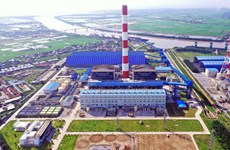Building materials industry under realignment
The domestic building materials market is expected to be knocked into
shape following the recent governmental approval of the sector’s master
plan until 2020 with a vision towards 2030, the Vietnam Investment
Review (VIR) reported.
The domestic building materials market is expected to be knocked into
shape following the recent governmental approval of the sector’s master
plan until 2020 with a vision towards 2030, the Vietnam Investment
Review (VIR) reported.
The prime ministerial Decision 1469/QD-TTg to greenlight Vietnam’s building material development has ordered limiting investment into certain materials that are currently in oversupply.
Accordingly, the Prime Minister has suggested stopping investment in building new ceramic tile production units from now until 2015. In the period from 2016 to 2020, this line of investment will get the go-ahead to reach the total designed capacity of 570 million square metres of ceramic tiles per year.
Statistics from the Ministry of Construction (MoC) showed that the total designed capacity of tiling materials should reach 450 million square metres per year in 2015, increasing to 570 million square metres per year in 2020.
In respect of natural masonry veneers, the Government has set the target for the total designed capacity of 15 million square metres per year in 2015, doubling to 30 million square metres per year by 2020. It expects to achieve these targets through production expansion or new investments.
The Prime Minister also demands using state-of-the art technology in the extraction process with minimal usage of explosives to limit environmental damage. Masonry veneer businesses are also encouraged to cooperate with calcium carbonate production units to reduce waste and alleviate environmental pollution.
Le Van Toi, Head of the MoC’s Building Materials Department told VIR that of the major building materials only cement had a detailed development plan based on actual market needs while most others did not, leading to the oversupply of many building materials in the market.
“In past years, building material units have used less-than-modern technologies and equipment which are high on fuel consumption and harmful to the environment. As well as that, the management of natural resources has been lax,” Toiwas quoted as saying, adding that the enactment of the new decision would help tackle these problems.
With regards to clay bricks, the Prime Minister has encouraged the production of large hollow clay bricks using modern technologies. Centrally-governed localities are required to work on a roadmap to gradually discontinue the use of furnaces that employ obsolete technologies.
The approved planning also forecasts that Vietnam’s total cement consumption will be 93 million tonnes by 2020. In the next period from 2020-2030, cement investment must follow the Prime Minister-approved cement development plan and the plan on exploration, extraction and use of minerals for the production of building materials.-VNA
The prime ministerial Decision 1469/QD-TTg to greenlight Vietnam’s building material development has ordered limiting investment into certain materials that are currently in oversupply.
Accordingly, the Prime Minister has suggested stopping investment in building new ceramic tile production units from now until 2015. In the period from 2016 to 2020, this line of investment will get the go-ahead to reach the total designed capacity of 570 million square metres of ceramic tiles per year.
Statistics from the Ministry of Construction (MoC) showed that the total designed capacity of tiling materials should reach 450 million square metres per year in 2015, increasing to 570 million square metres per year in 2020.
In respect of natural masonry veneers, the Government has set the target for the total designed capacity of 15 million square metres per year in 2015, doubling to 30 million square metres per year by 2020. It expects to achieve these targets through production expansion or new investments.
The Prime Minister also demands using state-of-the art technology in the extraction process with minimal usage of explosives to limit environmental damage. Masonry veneer businesses are also encouraged to cooperate with calcium carbonate production units to reduce waste and alleviate environmental pollution.
Le Van Toi, Head of the MoC’s Building Materials Department told VIR that of the major building materials only cement had a detailed development plan based on actual market needs while most others did not, leading to the oversupply of many building materials in the market.
“In past years, building material units have used less-than-modern technologies and equipment which are high on fuel consumption and harmful to the environment. As well as that, the management of natural resources has been lax,” Toiwas quoted as saying, adding that the enactment of the new decision would help tackle these problems.
With regards to clay bricks, the Prime Minister has encouraged the production of large hollow clay bricks using modern technologies. Centrally-governed localities are required to work on a roadmap to gradually discontinue the use of furnaces that employ obsolete technologies.
The approved planning also forecasts that Vietnam’s total cement consumption will be 93 million tonnes by 2020. In the next period from 2020-2030, cement investment must follow the Prime Minister-approved cement development plan and the plan on exploration, extraction and use of minerals for the production of building materials.-VNA












